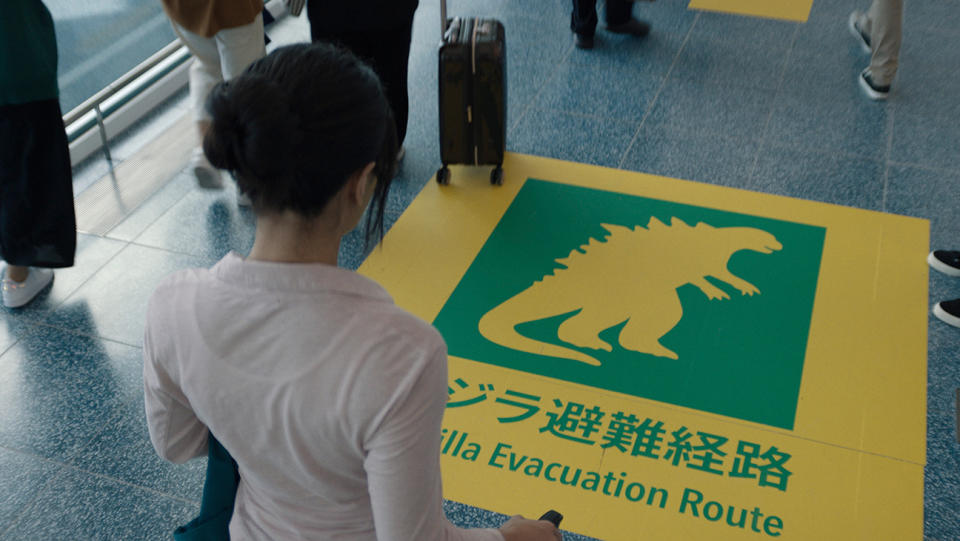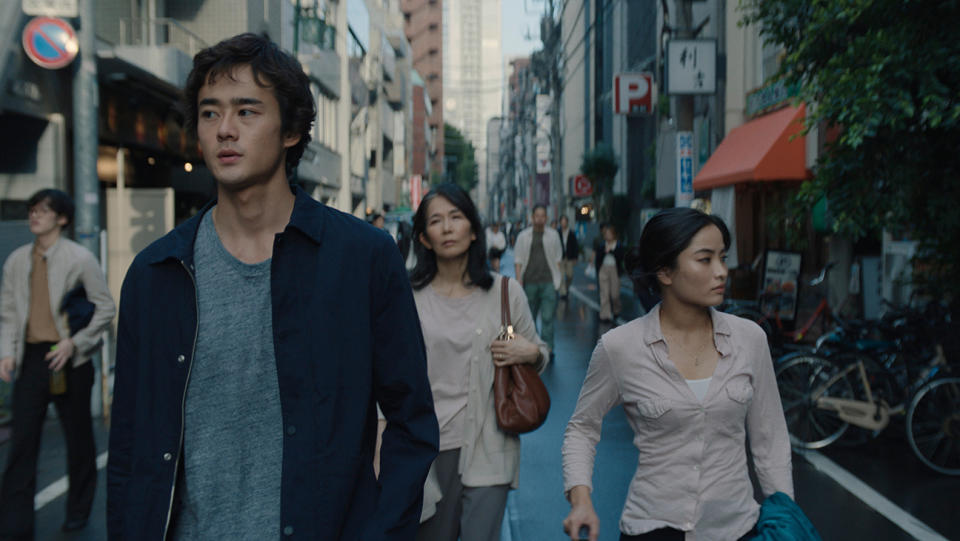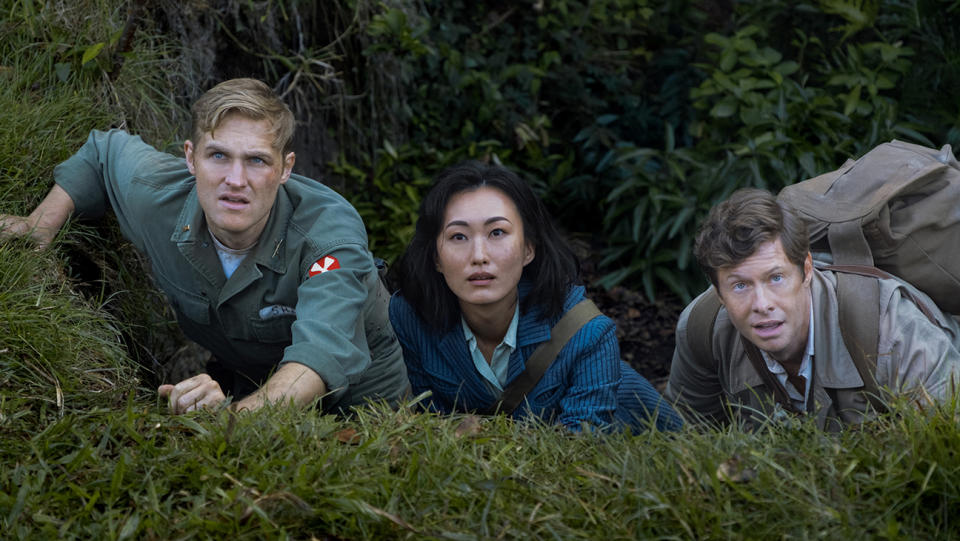‘Monarch: Legacy of Monsters’ Team on Adapting the Spectacle of the MonsterVerse for Television
- Oops!Something went wrong.Please try again later.

[This story contains spoilers for the first two episodes of Monarch: Legacy of Monsters.]
Monarch: Legacy of Monsters‘ team knows there are big expectations behind their entry in the Legendary monster franchise, home to Godzilla, King Kong and more Titans.
More from The Hollywood Reporter
But during a conversation with The Hollywood Reporter following their New York Comic Con panel last month, showrunner Chris Black and executive producer Matt Fraction said they weren’t intentionally trying to match the scale or even focus of Legendary’s monster movies. Instead, Black — a TV veteran — and Fraction, a writer with a hefty resume in the world of Marvel comics, were more interested in how the medium could help support — not hinder — the kind of story they could tell within the MonsterVerse.
“In the movies, the risk is always, ‘Are the protagonists going to die?’ In television, there’s 10 episodes. This is our cast, and we don’t want to get rid of them in episode four,” Fraction says. “When you come to this, it’s not because you want to worry that the characters are going to die. You want to see how they live.”
“We felt we couldn’t make a successful show that was just a show about monsters. It had to be a show about people who live in a world where monsters are real,” Black adds. “It was finding that delicate balance between the spectacle and the intimate human story. We knew as a practical reality, we have a generous budget with which to execute a big show, but we can’t do what the movies do.”
“And you shouldn’t try,” Fraction concludes.
The Apple TV+ series, which debuted Friday and releases weekly, dances between multiple timelines and across three generations. For example, in 1959, three people begin in the desert of Kazakhstan — a young Lee Shaw (Wyatt Russell), young William Randa (Anders Holm) and Keiko (Mari Yamamoto), on the search for the source of a disturbance.
In 2017, directly after the events of Warner Bros. 2014 Godzilla reboot, a young woman named Cate (Anna Sawai) comes to Japan to settle her renowned father Hiroshi’s (Takehiro Hira) affairs, but stumbles into a disturbing truth. He was living a double life, with a second family, which includes Cate’s half-brother, Kentaro (Ren Watabe) and his mother (Qyoko Kudo).
Alongside the older version of Shaw (portrayed by Kurt Russell), the mystery behind these monsters and the man who was chasing them are what bring all of these people together across time in a series the show’s creative team said worked carefully with Legendary to not tread on their cinematic universe counterparts.

It won’t ignore them either. Fans of the big screen films will be pleased to know Monarch literally begins with a sequence featuring John Goodman’s Randa, with the actor reprising his role from Kong: Skull Island. But Black and Fraction are confident that their story is a human one, grounded in a new take on the films that go beyond the clashes fans have come to love.
“To build a television show from the ground up, you have to create something that people want to return to again and again and again. So I think what will bring them back week after week is not necessarily big monster battles. It has to be a group of human beings that you want to follow that journey with,” Black explains.
For Fraction, that gave the show an opportunity to create characters, particularly in the 2017 storyline, that viewers could truly see themselves in. The main characters are not Monarch agents, scientists or special ops soldiers, but teachers and graphic designers. “Those are the people we wanted to throw into this world,” Black notes.
“They don’t have the special formula. They don’t have the secret invention. They are you and me having to take our shoes and belts off at the airport. They are on the ground floor of this new world,” Fraction continues. “And because [the show’s] about what comes next and how do you make it worse next time and more dangerous, part of the fun is that the longer you go, the gang starts to accrue experience in this world. So every time they level up, the stakes grow. It builds towards just an absolute cacophony.”
Focusing in on character is also opening the door for the franchise to explore its definition of monster in a different and equally deep way. Creatures like Godzilla and King Kong have long existed, like other classic Hollywood monsters such as the Wolfman, Frankenstein and Dracula, as representations of the times their movies were made in. They speak to a country’s cultural and societal fears; the subtle (and sometimes not so subtle) geopolitical tensions between places in the West and the East; the power of the natural world versus the industrialized one; and the legacy — including damage — those clashes leave behind.
With Monarch: Legacy of Monsters, Black and Fraction underscore that for season one, the biggest monster won’t be Skull Island‘s gigantic spiders or crabs, though they will certainly leave a mark or two on the humans who encounter them.
“Cate’s traumatic event is when her father leaves — not when Godzilla attacks,” Fraction says.
“It was being abandoned in her hour of need,” Black adds. “And obviously losing her students in the attack. But the defining trauma of her life — her father — that’s going to drive her.”

“The movies are about cities that get destroyed,” Fraction tells THR. “This is a show about the people who have been destroyed. Cate is the wreckage.”
That focus on the emotional arcs of Monarch‘s ensemble allows the series to explore, on a human level, the same kind of questions fans have had for decades about the Titans, whose destruction and defenses see them tip back and forth between the title of hero and villain. “It’s in episode three, I think, where Shaw says this is your legacy and Cate says this is my curse,” Black says. “That is what her journey is — her having to choose. Is this a curse or a legacy? Is this something I’m rejecting or something I’m accepting?”
“It was fun to play that against Kitaro over the course of this season,” notes Fraction. “Every new thing they learn, every new step they take, every new piece of the puzzle that they find, recontextualizes everything before. So they’re forever, each of them, feeling different and taking this journey that sometimes works together and sometimes doesn’t. It’s just fireworks all the time.”
That approach to its 2017 timeline also affected how the show tackled the flashbacks featuring Shaw, Bill and Keiko. Black reveals that the trio ultimately ended up with more scenes despite the fact that the 1950s timeline “early on in the development process, not intended to be as big a component as it is.”
“Then we found there was so much story to tell, and those characters were so interesting to follow,” he continues. “We realized they needed to be not a completely even split, but a lot more of that story.”
“Without giving things away, the function of the flashbacks are always to inform and background the present. But then also there are times when you can put the audience ahead of the characters in the present because you’ve seen their past,” Fraction adds. “So it was a way to not only to fill up the world and the mythology, but a way to underscore what was going on and make the present more relevant and more important — to create a richer texture and a bigger tapestry.”
Those flashbacks also help expand the timeline of the entire MonsterVerse. “All you’ve ever seen in the movies is as far back as the 1970s,” Black says. “Suddenly, there was so much room for us to play, even within the four movies.”

While the characters promise to be as — if not more — interesting than the monsters, the duo says that even on a smaller budget, fans can still expect their series to deliver on those legendary clashes. “We both come to this with a deep and abiding love of the monster universe, and we want to see those monsters as much as anybody does. So it was important to us that we not skim, and no spoilers, but the big guy comes back,” Black teases.
Fraction offers his own tease, seemingly even more excited about the new monsters their show gets to introduce. “We wanted to grow the world and the typography and zoology of it all,” he says.
“To earn it, too. That when they appear, it feels it was earned by the story. That something in our characters’ journey, in their search for their legacy, has put the monsters in their path. So it’s not random,” Black adds.
Beyond those epic battles, the monster encounters will affect the ensemble’s journeys, from what they’re learning about Hiroshi to what they’re learning about themselves.
“We didn’t have a formula where it’s been three episodes so we need to see a monster,” the showrunner explains. “It needed to be driven by, how do they present obstacles and opportunities for our characters? Then we’ve earned an appearance by either one of our legacy creatures like Godzilla — the ones who we love and grew up on — or the new ones because we wanted to expand the universe.”
“They’re in the character structure and story structure,” Franction concludes. “We’re building it around the family and these two siblings looking for their father.”
Monarch: Legacy of Monsters season one is streaming on Apple TV+.
Best of The Hollywood Reporter

